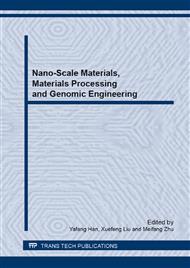[1]
J.C. Elliott, Structure and chemistry of the apatites and other calcium orthophosphates, Studies in inorganic chemistry, Amsterdam: Elsevier. 1994.
DOI: 10.1016/b978-0-444-81582-8.50004-3
Google Scholar
[2]
W. Suchanek, M. Yoshimura, Processing and properties of hydroxyapatite-based biomaterials for use as hard tissue replacement implant, J Mater Res. 13(1998) 94–117.
DOI: 10.1557/jmr.1998.0015
Google Scholar
[3]
H.A. Lowenstam, S. Weiner, On Biomineralization, Oxford University Press, Oxford. 1989.
Google Scholar
[4]
S. Koutsopoulos, Synthesis and characterization of hydroxyapatitecrystals: a review study on the analytical methods, J Biomed Mater Res. 62(2002) 600–12.
Google Scholar
[5]
A. Hideki, O. Masataka, K. Seisuke, Effects of HAP-sol on cell growth, Report Of Institute For Medical And Dental Engineering. 26(1992) 15–21.
Google Scholar
[6]
R. Dimitrious, G.C. Babis, Biomaterial osseointegration enhancement with biophysical stimulation, J Musculoskelet Neuronal Interact. 7(2007) 253-265.
Google Scholar
[7]
Currey, J. Biomaterials: sacrificial bonds heal bone, Nature, 414(2001) 699-708.
DOI: 10.1038/414699a
Google Scholar
[8]
A. Hideki, Science and Medical Applications of Hydroxyapatite, Tokyo: Japanese Association of Apatite Science, 1992: 137.
Google Scholar
[9]
B. Adriana, B. Elisa, C. Chiara, Strontium-substituted hydroxyapatite nanocrystals, Inorganica Chimica Acta. 360 (2007) 1009-1016.
DOI: 10.1016/j.ica.2006.07.074
Google Scholar
[10]
L. Elena, T. Anna, C. Giancarlo, Sr-substituted hydroxyapatites for osteoporotic bone replacement, Acta Biomaterialia. 3(2007) 961-969.
DOI: 10.1016/j.actbio.2007.05.006
Google Scholar
[11]
Danielle L, Neyvis A B, Nora H L et al. Magnesium incorporation into hydroxyapatite[J]. Biomaterials. 2011, 32: 1826-1837.
Google Scholar
[12]
C. Ilaria, B. Alessandra, L. Mariangela, Mg-substituted nanopowders: Synthesis, thermal stability and sintering behavior, Journal of the European Ceramic Society. 29(2009) 2969-2978.
DOI: 10.1016/j.jeurceramsoc.2009.04.038
Google Scholar
[13]
K. Lin, P. Liu, L. Wei, Strontium substituted hydroxyapatite porous microspheres: Surfactant-free hydrothermal synthesis, enhanced biological response and sustained drug release, Chemical Engineering Journal. 222(2013) 49–59.
DOI: 10.1016/j.cej.2013.02.037
Google Scholar
[14]
Z.L. Xiu, M.K. Lu, S.U. Liu, Barium hydroxyapatite nanoparticles synthesized by citric acid sol–gel combustion method, Materials Research Bulletin. 40(2005) 1617–1622.
DOI: 10.1016/j.materresbull.2005.04.033
Google Scholar
[15]
F.Z. Ren, R.L Xin, X. Ge, Characterization and structural analysis of zinc-substituted hydroxyapatites, ActaBiomaterialia. 5(2009) 3141–3149.
DOI: 10.1016/j.actbio.2009.04.014
Google Scholar
[16]
E. Bouyer, F. Gitzhofer, M. I. Boulos. Morphological study of hydroxyapatite nanocrystal suspension, J. Mater. Sci.: Mater. Med. 11(2000) 523-531.
Google Scholar
[17]
J. Guerra-López, R. Pomés, C.O. Della Védova, Influence of nickel on hydroxyapatite crystallization, J. Raman Spectrosc. 4(2001) 255-266.
DOI: 10.1002/jrs.689
Google Scholar
[18]
S. Okaayama, M. Akao, S. Nakamura, The mechanical properties and solubility of strontium substituted hydroxyapatite, Biomed. Mater. Eng. 1(1991) 11-1.
Google Scholar
[19]
Y. Yokogawa, M. Toriyama, Y. Kawamoto, Preparation of calcium strontiumapatite through mechanochemical method, Chem. Lett. 289(1996) 91-92.
DOI: 10.1246/cl.1996.91
Google Scholar
[20]
B. Donazzon, G. Dechambre, J. Lacout, Calcium-strontium hydroxyapatite hydrothermal preparation, Ann. Chim. Sci. Mat. 23(1998) 53-56.
DOI: 10.1016/s0151-9107(98)80010-x
Google Scholar
[21]
C. Capuccini, P. Torricelli, F. Sima, Strontium-substituted hydroxyapatite coatings synthesized by pulsed-laser deposition: In vitro osteoblast and osteoclast response, 4(2008) 1885–1893.
DOI: 10.1016/j.actbio.2008.05.005
Google Scholar
[22]
K.S. Suslick, G.J. Prkge, Applications of ultrasound to materials chemistry, Anny Rev Mater Sci. 229(1999) 295-326.
Google Scholar
[23]
T.J. Mason, Sonoelectrochemical effects in electro- organic systems, Ultrasonics Sonochemistry. 10(2003) 209-216.
Google Scholar


